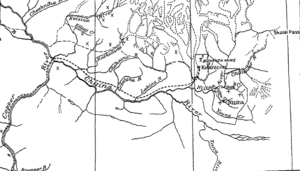Gilahina River facts for kids
The Gilahina River is a beautiful waterway located in the U.S. state of Alaska. It flows through the amazing Wrangell–St. Elias National Park and Preserve, which is a huge protected area. This river is an important part of the park's natural landscape.
Contents
Where the Gilahina River Begins
The Gilahina River starts high up in the mountains. These mountains are very tall, reaching about 6,000 to 7,000 feet high. The river begins between the Lakina River to its east and the Kuskulana River to its west.
The River's Journey and Length
The Gilahina River is about 12 miles long. It flows until it joins the larger Chitina River. This meeting point is about 9 miles downstream from where the Lakina River also joins the Chitina.
River Branches and Forks
About 3 miles before it reaches the Chitina River, the Gilahina River splits into two parts. This split is called a fork. The western branch of the river has its own name: the Chokosna.
The Chokosna branch is quite large. It drains an area of about 50 square miles. This means it collects water from a big section of land. The Chokosna is almost as big as the main Gilahina River before the fork.
How Steep is the River?
The Gilahina River flows downhill, and its slope changes along its path. For the first 6 miles of its journey through the mountains, the river drops about 150 feet for every mile it travels. This is called its "grade."
As the river gets closer to the Chitina Valley, the land becomes even steeper. For the last 6 miles of the Gilahina River, the average grade increases. Here, the river drops about 200 feet for every mile.
Water Quality and Valley Floor
The Gilahina River is known for its clear water. There are no glaciers in the area where the river flows. This means that usually, the water is clean and does not have much dirt or sediment in it.
The bottom of the river valley is made up of different materials. You can find gravel, large boulders, sand, and clay there. When the river is flowing very high, it can carry a lot of these materials. This causes the river's path to change over time.


